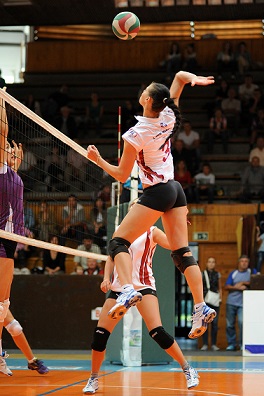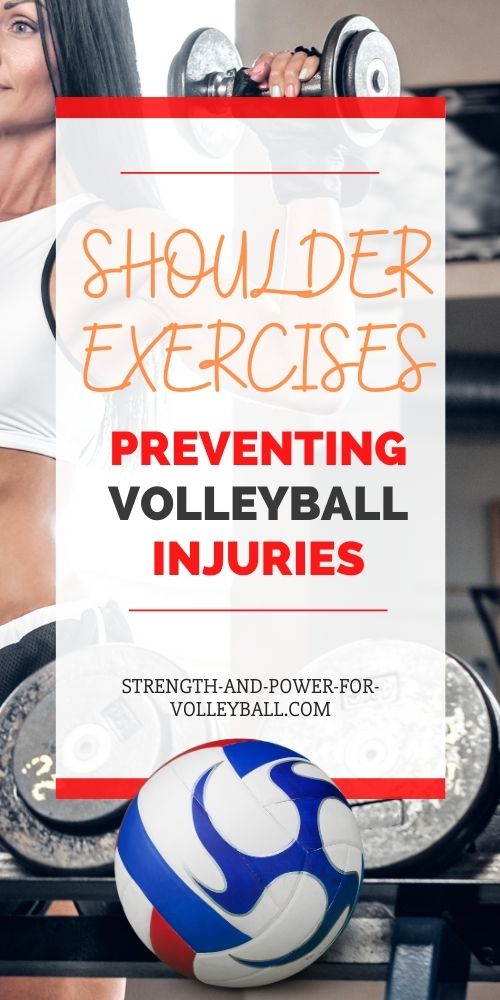- Home
- Smarter Training
- shoulder exercises for volleyball
Shoulder Exercises for Volleyball
Strength and Stabilization
Shoulder exercises for volleyball players help prevent injury. The key is strengthening the tiny muscles that connect to the shoulder blades (scapula).
Why strengthen at the scapula?
The scapula is half of the shoulder joint and essentially provides a base for shoulder movement.
Strengthening the rotator cuff muscles without strengthening the muscles that stabilize the scapula does only half the job.
The scapulothoracic joint (joint at the shoulder blade and rib cage) is an area that needs to be trained with short range isolating exercises.
Any scapular muscle weakness or inability to position the scapula and then stabilize can result in shoulder joint issues such as impingement, rotator cuff tendonitis, tendinosis, or tears.
Dysfunctional movement at the scapulae often leads to many rotator cuff problems. Scapular activation exercises should be part of volleyball weight training.
Shoulder Exercises for Volleyball Players
Physioball Y, T, W, L's
Y, T, W, L's can also be performed on an incline bench or in a standing position with hips slightly flexed.
Purpose:
Improve shoulder stability. Improve shoulder blade strength and recruitment patterns.
Start Position:
Lie facedown over the balance ball so your chest is up off the ball.
Y, T, W, L's are great for improving scapulothoracic stability thus helping prevent shoulder injuries at the rotator cuff. A workout program that leaves out scapular stabilizer exercises may be missing the key to preventing volleyball injuries that occur at the shoulder.
Physioball Y
-
Action:
While moving your shoulder blades back and down, lift your arms up above your head to form a Y. Lower your chest and arms and repeat. -
Coaching cues:
Keep your thumbs up throughout the movement. The top of your abdominals should stay at the center of the ball.
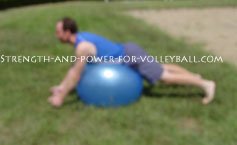
Physioball Y Start Position
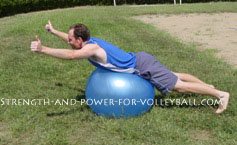
Physioball Y Bottom Position
Physioball T
-
Action:
Move your shoulder blades in toward your spine, and extend your arms to your sides making a T with your torso. -
Coaching cues:
Keep your thumbs pointed up while keeping your arms long and straight throughout the movement. Keep your head and neck in alignment with your spine. Squeeze your shoulders blades together as you pull your shoulders back and down.
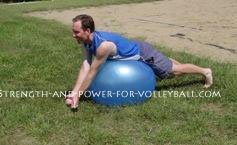
Physioball T Bottom Position
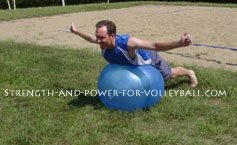
Physioball T Top Position
Physioball W
-
Action:
Move your elbows in toward ribs. Squeeze your shoulder blades together while rotating your thumbs back toward the ceiling. Continue rotating your hands back as far as possible while forming a W. -
Coaching cues:
Keep your thumbs pointed up while keeping your arms long and straight throughout the movement. Keep your head and neck in alignment with your spine. Squeeze your shoulders blades together as you pull your shoulders back and down.
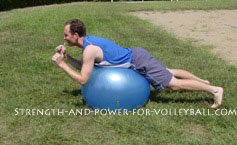
Physioball W Bottom Position
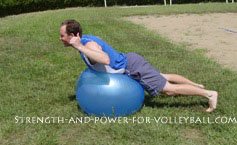
Physioball W Top Position
Physioball L
-
Action:
Bend your elbows until you create a 90 degree angle. Raise your upper arm until they are 90 degrees to your torso, creating a pair of L's. Hold that position and externally rotate (move the back of the hand forward and up). Slowly retrace the movement pattern back to the start. -
Coaching cues:
Squeeze your shoulder blades together while keeping your shoulders back and down. Rotate your hands back as far as you can.
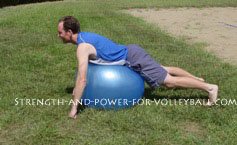
Physioball L's Bottom Position
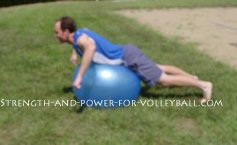
Physioball L's Arms at 90 degrees
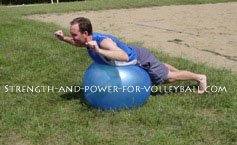
Physioball L's Top Position
Y, T, W, L's can be a great addition to a volleyball weight training program because of the functionality of improving stability of the entire shoulder joint.
The Stability Ball I Recommend
Band Pull Shoulder Exercises for Volleyball
-
Purpose:
Stretch pecs and activate muscles of the upper back. -
Starting Position:
Hold a resistance band at arms length and shoulder level while placing your hands about shoulder width apart -
Action:
Pull your elbows back as you pull the band apart by using the muscles of your upper back. -
Coaching cues:
Focus on bringing your shoulder blades together. Keep your hands and elbows at shoulder height.
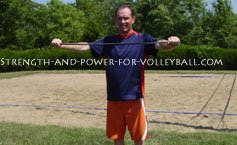
Band Pulls Starting Position
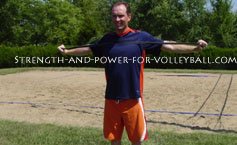
Band Pulls Finish Position
Stick Ups
Stick ups improve the muscle activation and strength of the lower trapezius.
-
Purpose:
Improve shoulder mobility and postural control. -
Starting Position:
Stand with your back against the wall. Your head, upper back, and butt should remain in contact with the wall at all times. Stick your hands up over your head. -
Action:
Slide your arms down the wall and move your elbow in toward your sides squeezing your shoulder blades together. Stick your hands back up and repeat the movement. -
Coaching cues:
Try to keep your shoulders, elbows and wrists in contact with the wall at all times during the movement. You should feel muscles contract at your shoulders and between the shoulder blades.
If you enjoyed these tips and would like to keep it close to you at any time, just save this pin to your Pinterest Volleyball Training Board.
Volleyball Weight Training for Upward Rotation
Weight training programs need shoulder exercises for volleyball that work opposing muscle groups in order to avoid creating muscular imbalances.
For example, a workout that includes a bench press should have a row type movement to balance out the pushing movement of the bench press.
While this is good when thinking of how to train large muscles, the balancing of the smaller muscles of the shoulder need to be considered. Both exercises train retraction of the scapula. Training retraction without training protraction can lead to muscular imbalances and shoulder problems.
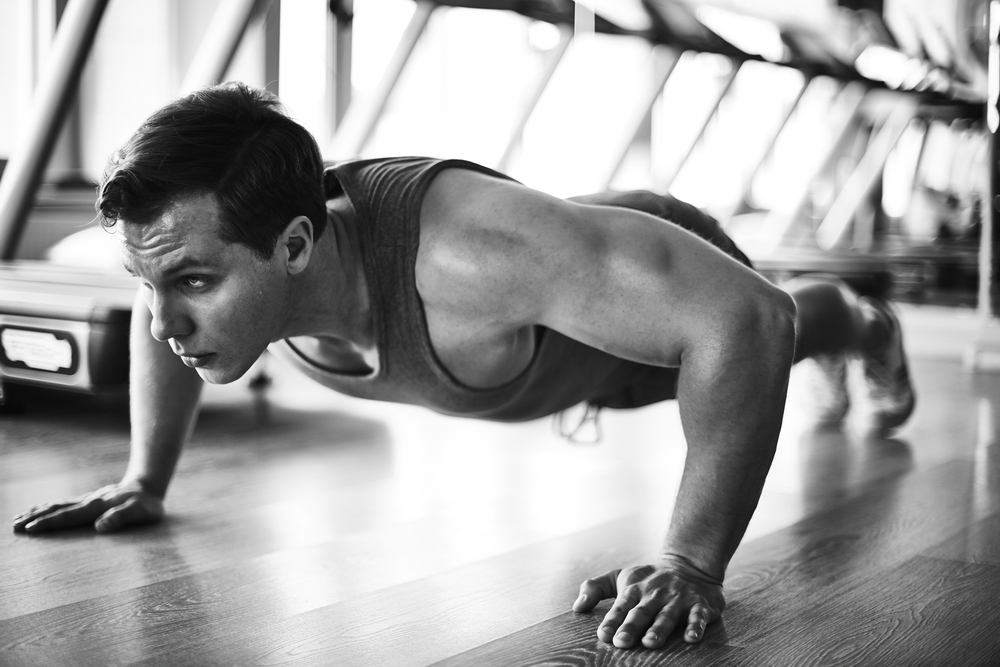
Push ups are Great Shoulder Exercises for Volleyball
Common multi-joint exercises such as the bench press, pull up, and bent row can lead to an ineffective upward rotation of the scapula, which can then lead to rotator cuff injury of athletes that perform overhead throwing movements (volleyball player spiking a volleyball).
The overhead shrug allows you to perform a shrugging movement with the scapula in an upwardly rotated position while mainly strengthening the upper trapezius.
-
Overhead shrugs
Purpose:
Strengthening the upper trap with an upward rotation of the scapula.
Starting Position:
Stand holding a barbell at about power snatch grip width. You can also use a resistance band for this exercise. Stand on the band and stretch it up overhead, stretching it apart with your hands.
Action:
With arms straight, shrug your shoulders.
Coaching cues:
Shrug as high as you can, activating your upper trapezius. Hold for a second at the top of the movement. -
Push up plus
The serratus anterior enforces protraction (forward movement at and around the rib cage). A weak serratus leads to poor positioning of the scapulae. The pushing away motion is what allows the scapulae to protract. Including push-up variations in volleyball weight training is an easy and effective way of increasing shoulder strength and stability.
Purpose:
Improve activation and strength of the serratus anterior muscle.
Starting Position:
Get in a basic push up position (on toes, stomach tight and in a line with upper back and hips). Come to the top of the push up movement.
Action:
From this top position, push your body as far away from the floor as possible. This 'push' emphasizes proper serratus function. Hold this position for a second then return to the starting position.
Coaching cues:
Make sure the movement comes at the scapulae by keeping your core tight and your body inline with your hips and upper back, not by flexing your spine forward.
The mobility or stability of the scapulae can have a direct effect on the strength and proper function of the rotator cuff.
Shoulder exercises for volleyball help increase mobility and stability of the scapulae.
